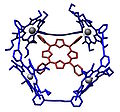Porphyrin
| Advanced search |
- About 3 results found and you can help!
 Brilliant crystals of meso-tetratolylporphyrin, prepared from 4-methylbenzaldehyde and pyrrole in refluxing propionic acid |
Porphyrins are a group of organic compounds, many naturally occurring. One of the best-known porphyrins is heme, the pigment in red blood cells; heme is a cofactor of the protein hemoglobin. Porphyrins are heterocyclic macrocycles composed of four modified pyrrole subunits interconnected at their α carbon atoms via methine bridges (=CH-). Porphyrins are aromatic. That is, they obey Hückel's rule for aromaticity, possessing 4n+2 π electrons (n=4 for the shortest cyclic path) delocalized over the macrocycle. Thus porphyrin macrocycles are highly conjugated systems. As a consequence, they typically have very intense absorption bands in the visible region and may be deeply colored; the name porphyrin comes from a Greek word for purple. The macrocycle has 26 pi electrons in total. The parent porphyrin is porphine, and substituted porphines are called porphyrins. The specific porphyrin in heme B (see Figure) is called protoporphyrin IX and has 4 methyl, two vinyl, and two propionic acid substituents at the indicated positions.
- See also: Wikipedia
- Related: Add a related term
| Journal of Porphyrins and Phthalocyanines Journal of Porphyrins and Phthalocyanines www.worldscinet.com/jpp/ - Web |
| Handbook of Porphyrin Science Handbook of Porphyrin Science www.worldscibooks.com/chemistry/7376.html - Web |
| Porphynet - an informative site about porphyrins a... Porphynet - an informative site about porphyrins and related structures www.porphyrin.net - Web |
Gallery for «Porphyrin»
Average relevance

